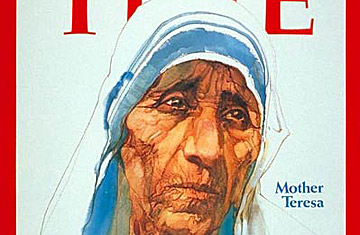
Mother Teresa
(6 of 10)
Mother Teresa by no means rejects the fruits of modern society if they can help her work. Pope Paul VI, on a 1964 visit to India, left her a white Lincoln limousine that had been given to him. She promptly raffled it off for a profit of some $100,000. She treasures other useful gifts: a streetcar pass for Calcutta's trams, a railroad pass for India's trains, an Indian Airlines pass that gives her free domestic flights. In 1973, Imperial Chemical Industries gave Mother Teresa a former paint-manufacturing plant, which she quickly filled with children, the sick and dying, and mentally ill women. She has also started a small but flourishing copra industry there that gleans its raw materials, coconut shells, from the litter left on Calcutta streets by thousands of coconut-milk sippers.
For all the shrewd organizing sense with which she is sometimes credited, Mother Teresa remains otherworldly. She suffers journalists and photographers only because publicity may help her people. After Photographer Jean-Pierre Laffont cajoled her into posing for the portrait from which TIME'S cover was painted, she told him that she had prayed for a special favor at Mass the morning of the sitting. For every picture he took, she had asked God to "free one soul from Purgatory." Two years ago, after she had accepted the Templeton Prize for "progress in religion" in London, one of her co-workers asked where the prize was. When she could not find it, a frenzied search of the auditorium ensued. There, on a chair in a corner, was the envelope —with a check for £34,000 inside.
God, after all, continued to provide.
Mother Teresa is unique; yet the world has many who share her kind of faith and fervor. Each sister and brother in the Missionaries of Charity is a story in courage. And beyond her circle are thousands of others.
"We are surrounded by persons with saintliness," says Anglican Dean Herbert O'Driscoll of Christ Church Cathedral in Vancouver, B.C., "the elderly living full, triumphant lives in great pain, persons loving to the full where no love is returned. That is the uncelebrated sainthood going on about us every day."
Even the spiritual heroes, whose special tasks or character draw attention and emulation, seem to rise up in abundance for those who look for them. Many, like Mother Teresa, live by the standard set in Matthew: 25. They feed the hungry, clothe the naked, visit the sick and imprisoned. These works of mercy draw attention because they are deeds that even a world without faith can recognize as good. Yet those who practice them usually lead intense spiritual lives.
Annie Skau is a Norwegian Evangelical nurse who traces her vocation to a direct call from God. Praying in the forest one day, she heard a voice ask, "Will you go for me to China?" and in 1938 she went to Shensi province as a medical missionary. Expelled by the Communists in 1951, she moved to Hong Kong, where her 6-ft. 5-in. frame became a familiar sight as she directed the construction of a 300-bed tuberculosis hospital. Now limited by a heart condition to three or four working days a week, she still rises before dawn to read the Bible. "The old Christian who has lived and walked with the Lord for many years," she says, "is living in a treasure chamber."
